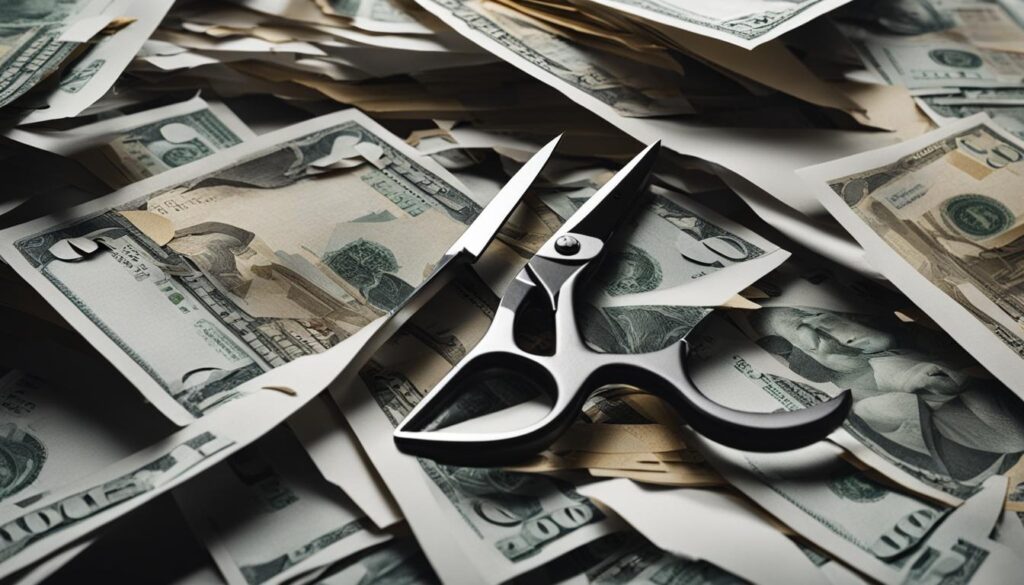Welcome to our Frugal Lifestyle Hub, where we provide practical tips and strategies for embracing a frugal lifestyle during times of economic hardship. In today’s challenging economic climate, it’s essential to find ways to make every dollar count. Whether you’re facing financial difficulties or simply looking to adopt a more sustainable and minimalist lifestyle, our cost-saving tips will help you thrive while living on less.
Key Takeaways:
- Embrace a frugal lifestyle to navigate economic hardship
- Prioritize essential expenses to allocate your funds wisely
- Embrace resourcefulness and seek out DIY approaches to save money
- Shop smart and take advantage of deals and discounts
- Reevaluate subscriptions and contracts to cut unnecessary costs
Prioritizing Essential Expenses: Making Every Dollar Count
During times of economic hardship, it’s essential to prioritize your expenses and make every dollar count. By carefully managing your budget and cutting costs where possible, you can create a solid financial foundation for yourself and your family. Here are some key strategies for prioritizing essential expenses and maximizing your financial management:
1. Distinguish between needs and wants
To effectively allocate your funds, it’s important to distinguish between essential needs and discretionary wants. Focus on covering your basic necessities such as housing, groceries, utilities, and healthcare. These should be your top priorities, while discretionary expenses like dining out, entertainment, and non-essential purchases can be trimmed or eliminated altogether.
2. Create a budget
Budgeting is a fundamental aspect of financial management. Take the time to assess your income, fixed expenses, and variable expenses. Allocate a specific amount of money towards each essential expense category and track your spending accordingly. This will help you stay on track and make informed decisions about where to cut costs.
3. Cut back on unnecessary costs
Identify areas where you can cut back on unnecessary costs. Look for ways to save on everyday expenses such as reducing energy consumption, shopping for groceries strategically, and exploring more affordable healthcare options. Consider alternatives to expensive habits and activities, opting for free or low-cost alternatives that align with your values and interests.
| Expense Category | Monthly Budget | Actual Spending |
|---|---|---|
| Housing | $1,000 | $950 |
| Groceries | $300 | $250 |
| Utilities | $200 | $180 |
| Healthcare | $150 | $130 |
By prioritizing your essential expenses and cutting back on unnecessary costs, you can create a solid financial foundation and make every dollar count.
By implementing these strategies, you can navigate economic hardships with financial resilience. Remember that prioritizing essential expenses doesn’t mean depriving yourself, but rather making thoughtful choices that align with your financial goals. By managing your budget, distinguishing between needs and wants, and finding ways to cut back on unnecessary costs, you can maximize your financial management and make your money work for you.
https://www.youtube.com/watch?v=6xxK9kgNlkA
Embracing Resourcefulness: DIY and Frugality
Resourcefulness is a valuable skill for those seeking a frugal lifestyle. By embracing do-it-yourself (DIY) approaches, you can save money and discover the satisfaction of creating things yourself. Whether it’s tackling repairs, maintenance, or finding low-cost entertainment options, being resourceful allows you to make the most of your budget while still enjoying a fulfilling life.
One way to embrace resourcefulness is by honing your DIY skills. Instead of hiring professionals for home repairs, consider learning how to fix minor issues yourself. With an abundance of online tutorials and guides, you can acquire the knowledge and confidence to handle various tasks around the house. Not only will you save money on labor costs, but you’ll also develop new skills and a sense of empowerment.
Additionally, look for opportunities to repurpose items or create your own. Take inventory of what you already have and brainstorm creative ways to give them new life. Upcycling old furniture, repurposing jars for storage, or turning scrap materials into home decor are just a few examples of how you can tap into your resourcefulness and save money in the process.
Quotes:
“Being resourceful means making the most of what you have and finding creative solutions to everyday challenges. It’s about thinking outside the box and utilizing your skills and imagination to save money and live a more sustainable lifestyle.”
Furthermore, seek out free or low-cost activities that align with your interests. Explore your local community for events, workshops, and classes that provide opportunities for growth and enjoyment without breaking the bank. Whether it’s joining a book club, participating in community gardening, or attending free concerts in the park, being resourceful allows you to find joy in simple pleasures and meaningful experiences.
Embracing resourcefulness is not only about saving money but also about adopting a mindset of sustainability. By reducing waste, repurposing items, and utilizing your skills, you contribute to a more eco-friendly lifestyle. The benefits of resourcefulness extend beyond financial savings, as it enables you to live a more mindful and purposeful life.
| Benefits of Embracing Resourcefulness | How to Embrace Resourcefulness |
|---|---|
| 1. Cost savings | 1. Develop DIY skills through online tutorials and guides |
| 2. Increased self-sufficiency | 2. Repurpose items and find creative ways to use what you already have |
| 3. Sustainable living | 3. Seek out free or low-cost activities in your community |
| 4. Expansion of knowledge and skills | 4. Foster a mindset of sustainability through reducing waste |

Embracing resourcefulness goes hand in hand with frugality. By adopting a mindset of finding creative solutions, you can save money, reduce waste, and live a more fulfilling life. Whether it’s through DIY projects, repurposing items, or seeking out low-cost activities, being resourceful empowers you to make the most of your resources while contributing to a more sustainable future.
Shop Smart: Finding Deals and Savings
When it comes to frugal living, shopping smart is key. By being strategic with your purchases and taking advantage of deals and savings, you can stretch your budget and make every dollar count. Here are some tips to help you shop smart and save money:
1. Compare Prices
Before making a purchase, take the time to compare prices from different retailers. Online shopping makes it easy to compare prices, but don’t forget to check local stores as well. Look for discounts, promotions, and coupon codes that can further reduce the price.
2. Use Coupons and Discount Codes
Coupons and discount codes are a fantastic way to save money on your purchases. Look for coupons in newspapers, magazines, and online coupon websites. Many stores also offer loyalty programs or email newsletters that provide exclusive discounts and promotions.
3. Take Advantage of Sales and Clearance
Keep an eye out for sales and clearance events, both online and in-store. These are great opportunities to score big savings on items you need. Consider buying seasonal items during off-season sales to get the best deals.
4. Shop in Bulk
If you frequently use certain products, consider buying them in bulk. Warehouse clubs and online retailers often offer discounted prices when you buy in larger quantities. Just make sure you have enough storage space and that the items won’t expire before you can use them.
By shopping smart and being mindful of your purchases, you can save significant amounts of money without sacrificing quality or value. Remember to always prioritize your needs over wants and think long-term when making buying decisions. With a little planning and research, you can become a pro at finding deals and savings.
| Store | Product | Regular Price | Sale Price | Discount |
|---|---|---|---|---|
| Store A | Shoes | $50 | $40 | 20% off |
| Store B | Electronics | $500 | $400 | 20% off |
| Store C | Clothing | $30 | $20 | 33% off |
| Store D | Home Appliances | $1000 | $800 | 20% off |

Reevaluating Subscriptions and Contracts: Cutting Costs
When it comes to cutting costs and living a frugal lifestyle, reevaluating your subscriptions and contracts can make a significant impact on your monthly expenses. Take a closer look at the services you’re currently subscribed to and consider whether they are still necessary or if more affordable alternatives are available.
Start by assessing your cell phone plan. Explore different providers and compare their rates and packages. You may find that switching to a lower-cost plan can save you a significant amount of money each month without sacrificing quality or coverage. Remember, it’s essential to choose a plan that suits your needs and usage patterns.
| Service | Monthly Cost | Renewal Date |
|---|---|---|
| Cell phone plan | $60 | 15th of every month |
| Cable subscription | $80 | 1st of every month |
| Streaming services | $25 | Varies |
Next, evaluate your cable subscription. Consider whether you truly need all the channels and packages you’re currently paying for. Explore streaming services as an alternative, which often provide a wide range of content at a fraction of the cost. You can also consider cutting the cord entirely and relying solely on streaming services for your entertainment needs.
Lastly, review your other subscriptions and recurring expenses. This may include gym memberships, magazine subscriptions, and other monthly commitments. Determine if these expenses align with your current priorities and if there are any lower-cost alternatives available.
“It’s important to regularly reassess your subscriptions and contracts to ensure they align with your financial goals. Cutting costs in these areas can free up more money for essential needs and savings.” – Financial Advisor
By reevaluating your subscriptions and contracts, you can identify areas where you can cut costs and allocate those savings towards more critical areas of your budget. Making these adjustments may require some initial research and time investment, but the long-term financial benefits will be worth it.

Conclusion
Frugal living during economic hardship is a strategic approach to maximize our financial well-being while still enjoying a fulfilling life. By carefully prioritizing essential expenses, embracing resourcefulness, shopping smart, and reevaluating subscriptions and contracts, we can navigate tough times and build a strong financial foundation.
Living frugally does not mean depriving ourselves. It means making mindful choices and finding joy in the simple pleasures that life offers. It’s about cultivating a minimalist lifestyle where we focus on what truly matters and let go of unnecessary expenses.
With a frugal mindset and financial discipline, we can thrive even during economic challenges. Budgeting becomes a powerful tool that allows us to allocate our resources wisely, ensuring that every dollar counts. By adopting sustainable living practices and being mindful of our consumption, we not only save money but also contribute to a more eco-friendly and responsible future.
FAQ
How can I prioritize essential expenses during economic hardship?
Distinguish between needs and wants to allocate your funds wisely. Housing, groceries, utilities, and healthcare should be top priorities. Cut back on discretionary expenses such as dining out and entertainment.
How can I embrace resourcefulness to save money?
Learn to tackle repairs, maintenance, and even entertainment on your own through do-it-yourself (DIY) approaches. Seek out free or low-cost activities that align with your interests. By being resourceful and creative, you can save money while still enjoying a fulfilling life.
What are some tips for shopping smart and finding deals?
Compare prices, use coupons, and take advantage of sales and discounts to save money on essential items. Look for deals on groceries and everyday products without compromising quality. By shopping smart, you can stretch your budget and make every dollar count.
How can I cut costs by reevaluating my subscriptions and contracts?
Take a closer look at your subscriptions, contracts, and recurring expenses to identify areas where you can cut costs. Consider whether they are still necessary or if more affordable alternatives are available. Switching to lower-cost options for cell phone plans, cable subscriptions, and streaming services can make a significant impact on your monthly expenses.
How Can I Save Money During a Recession?
During a recession, it’s crucial to prioritize saving. To help you navigate these tough times, here are a few essential recession saving tips. First, create a budget to track your expenses and identify areas where you can cut back. Second, save on groceries by planning meals, buying in bulk, and shopping for sales. Additionally, consider downgrading subscriptions, searching for cheaper insurance, and avoiding unnecessary purchases. By implementing these recession saving tips, you can build a financial safety net while weathering economic uncertainty.


Pingback: Giving Wisely: Charitable Giving During Economic Hard Times! – Straight Fire Money